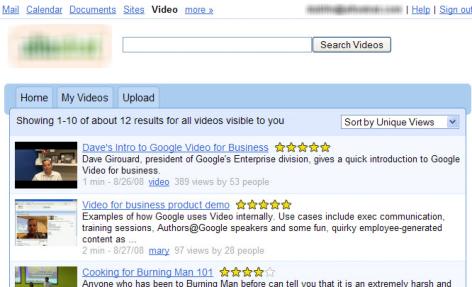Google adds video to the virtual workplace

Google Apps Premier users now have a new option in their application menu: video. Google has combined its existing YouTube infrastructure with the authorization and permissions infrastructure of Google Apps to create a video sharing option for users of its business collaboration suite. Users can upload videos for sharing with selected colleagues, either embedded in documents and spreadsheets or within the video sharing application, where users can vote for favored videos, add comments and feedback, and search by title or other metadata (see screenshot below).
Adding collaborative video sharing underlines the disruptive nature of the Google Apps suite, breaking new ground rather than merely replicating what's already available from conventional on-premise office products. Google's YouTube property has helped demonstrate the power of online video sharing in the consumer world for entertainment, messaging and knowledge transfer — just try Googling the phrase 'how to' to see how commonplace it's become to use online video as a way of learning skills such as applying makeup, tying a tie or performing massage. Google's new application provides a business-friendly infrastructure for disseminating information and how-to skills using the power of video. But at the same time as making it easy to upload video for sharing, the vendor has been careful to make sure there's no easy way of publishing video content beyond its intended audience.The new application does however show up the inflexibility of the Google Apps subscription model. I can imagine that many organizations might find it useful to enable video sharing for a subset of users without wanting to upgrade everyone to the $50-per-year premier licence. This would help Google increase its monetization of users who are currently on the ad-funded standard edition. But there's no option for two-tier licensing with Google Apps — an organization must either put all its users on the paying edition, or leave them all on the ad-funded version. I suspect few will see video sharing as a reason in itself to upgrade, so the capability currently is more like icing on the cake for those that have already decided on the premier edition for other reasons.
Nevertheless, it's intriguing to see Google taking collaboration in this refreshing direction. When the Web first came along, did anyone imagine that one of the consequences would be so much sharing of user-generated video? We're now starting to see the emergence of disruptive uses of Web technology — people doing things that wouldn't have been practical or even imaginable a decade ago. This is the point at which the real benefits of the technology start to be realized — when we move out of the 'horseless carriage' phase (defining the phenomenon in terms of what went before) and we really start motoring.
The new capability does add an interesting perspective on the news that Google is also releasing its own browser today. If it's going to become increasingly commonplace for people to edit and share video material then it really does increase the case that I discussed last week for a more powerful client than existing browsers. That seems to be part of the thinking behind Chrome. As Google said on its blog, "the web had evolved from mainly simple text pages to rich, interactive applications and that we needed to completely rethink the browser. What we really needed was not just a browser, but also a modern platform for web pages and applications." Michael Arrington makes the point that Chrome should be assessed in tandem with Gears, which extends the browser to take advantage of client resources. "Expect to see millions of web devices, even desktop web devices, in the coming years that completely strip out the Windows layer and use the browser as the only operating system the user needs. That was going to happen anyway, but Chrome + Gears just made the decision a whole lot easier for hardware manufacturers to make."
